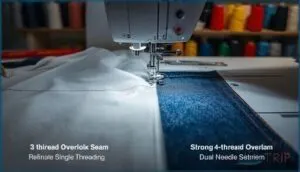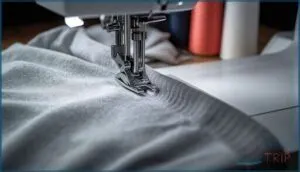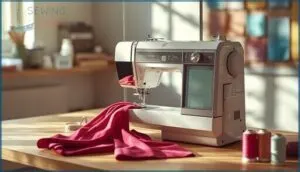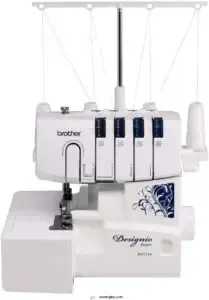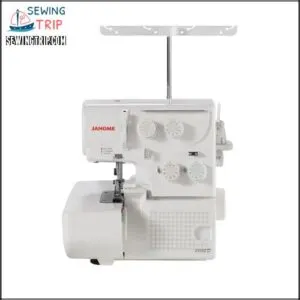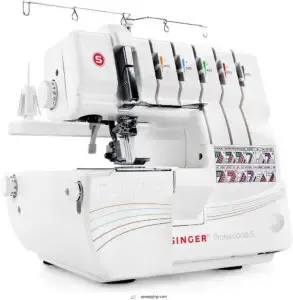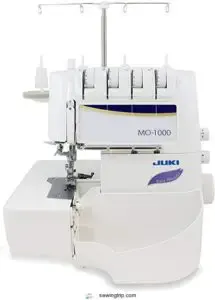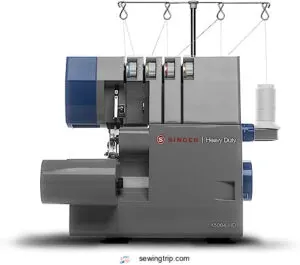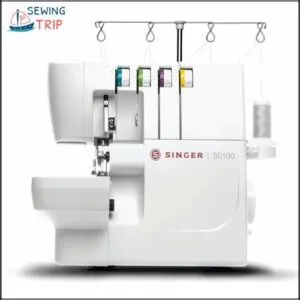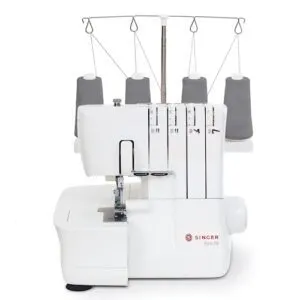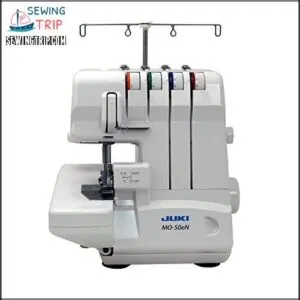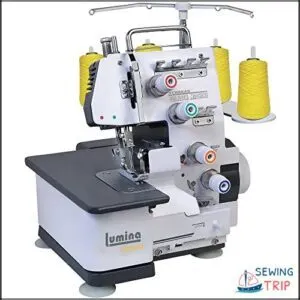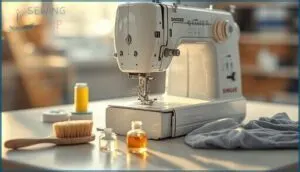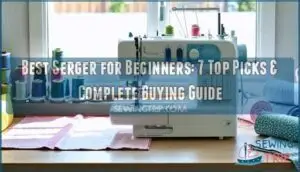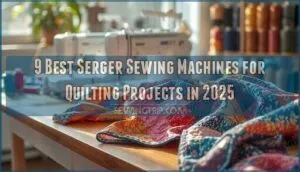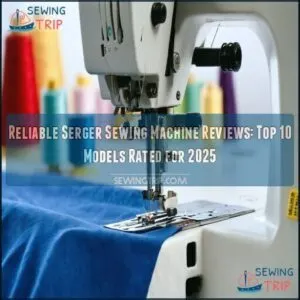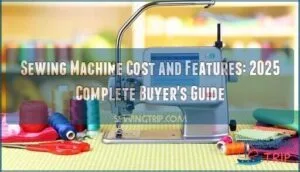This site is supported by our readers. We may earn a commission, at no cost to you, if you purchase through links.
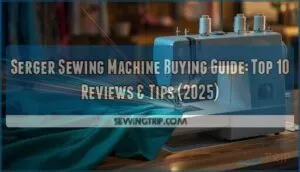
Professional garment makers know a secret: sergers transform homemade clothing into pieces that rival ready-to-wear quality. These specialized machines trim, stitch, and finish edges in one smooth motion, creating clean seams that won’t unravel or fray. Unlike regular sewing machines that cap out around 850 stitches per minute, sergers can hit 1,300, cutting your project time nearly in half.
They’re particularly excellent at taming stretchy fabrics—knits, jerseys, and activewear materials that usually cause headaches on standard machines. Whether you’re outfitting your family, launching a small business, or simply tired of store-bought hems that fall apart after three washes, choosing the right serger requires understanding which features actually matter for your specific projects and budget.
Table Of Contents
- Key Takeaways
- What is a Serger Sewing Machine?
- Essential Features to Look for in a Serger
- Comparing Serger Stitch Options
- How to Choose The Right Serger for You
- Top 10 Serger Sewing Machines Reviewed
- 1. Brother Designio DZ1234 Serger Machine
- 2. Janome 8002D Serger Overlock Sewing Machine
- 3. Singer Professional Heavy Duty Serger
- 4. Brother Coverstitch Serger Sewing Machine
- 5. Juki MO-1000 Air Threading Serger
- 6. Singer Heavy Duty Metal Frame Serger
- 7. Singer S0100 Serger Overlock Machine Kit
- 8. Singer S14-78 Serger Sewing Machine
- 9. Juki MO 50E Sewing Serger
- 10. Lumina Sienna Serger Sewing Machine
- Tips for Serger Maintenance and Longevity
- Frequently Asked Questions (FAQs)
- Conclusion
Key Takeaways
- Sergers create professional-quality seams by trimming, stitching, and finishing fabric edges simultaneously at speeds up to 1,300 stitches per minute—nearly 50% faster than standard sewing machines while preventing fraying and handling stretchy fabrics that cause problems on regular machines.
- Essential features worth prioritizing include adjustable differential feed (0.5-2.0 ratio) for preventing puckering on knits and delicates, color-coded or air-threading systems that cut setup time from 10 minutes to under 90 seconds, and metal frame construction that outlasts plastic models by 35% while reducing vibration.
- Thread configuration matters more than stitch count—3-thread overlock works well for lightweight fabrics and uses 28% less thread, while 4-thread overlock delivers 25-40% greater seam strength for activewear and denim, and coverstitch machines add professional hems but can’t replace a full serger’s trimming capabilities.
- Regular maintenance extends your serger’s lifespan to 15-25 years through simple habits like removing lint after each project, oiling every 8-10 hours of use, replacing needles every 6-8 hours, and changing blades annually when you notice frayed edges or reduced cutting efficiency.
What is a Serger Sewing Machine?
A serger might look like a regular sewing machine’s more complicated cousin, but it’s actually designed to do something your standard machine can’t quite pull off. While your sewing machine takes care of most construction tasks, a serger trims, finishes, and seams fabric edges all at once with professional results.
Let’s break down what sets these machines apart, why you’d want one, and what you can actually make with it.
Key Differences Between Sergers and Sewing Machines
While a sewing machine works with zippers and decorative stitching, a serger machine specializes in seam finishing with built-in trimming blades. Here’s what sets them apart:
- Stitch variety: Sergers produce overlock and rolled hem stitches using 3–5 threads, while sewing machines offer up to 200 stitch types
- Speed comparison: Sergers reach 1,300 stitches per minute versus 850 for most consumer models
- Fabric handling: Differential feed in sergers prevents stretch fabric distortion
Sergers excel at working with stretchy and knit fabrics, preventing fraying and ensuring seams stretch without breaking.
Benefits of Using a Serger
Understanding these differences helps you see why a serger machine earns its place in your sewing space. Sergers work 30–50% faster than regular machines, allowing you to achieve professional finishes with striking speed efficiency.
Seam strength improves by up to 30% on stretch fabrics, while edge finishing reduces fraying by 90%. The real advantage? Your serger sewing performs simultaneous tasks: trimming, stitching, and overcasting in one pass, boosting fabric versatility across knits to denim.
Sergers are especially useful because they create overlock stitches that are flexible and durable.
Common Applications and Project Types
Now that you know the key benefits, where does a serger shine in real-world sewing projects? Over 65% of home users rely on sergers for garment construction, especially knit garments and activewear that demand stretch and durability.
Your serger excels in three main areas:
- Garment Construction – Professional seam finishing on clothing, from T-shirts to swimwear
- Home Décor – Rolled hems on tablecloths, napkins, and curtains
- Crafting Projects – Decorative edges and specialty trims for quilts
Industrial uses and educational purposes round out the applications.
Essential Features to Look for in a Serger
Shopping for a serger can feel overwhelming when you’re staring at rows of machines with unfamiliar specs and features. The good news is that focusing on a few key elements will help you separate the models worth your money from those that’ll gather dust.
Let’s break down the essential features that actually make a difference in your day-to-day sewing.
Adjustable Stitch Width and Length
Think of adjustable stitch width and length as your serger’s precision controls—they’re the difference between a professional finish and a puckered mess. Most modern sergers offer stitch lengths between 1.0 mm and 4.0 mm, and widths from 3 mm to 7.5 mm. These settings directly impact fabric compatibility, seam appearance, and stitch durability across projects.
Proper adjustment ensures edges stay enclosed and seams won’t unravel—critical for project outcomes that last through wear and washing.
| Setting | Best For |
|---|---|
| Narrow width (3mm) | Delicate silks, sheer fabrics |
| Wide width (7mm) | Heavy denim, thick textiles |
| Short length (1-2mm) | Strong seams, lightweight materials |
| Long length (3-4mm) | Basting, gathering, flexible finishes |
Differential Feed and Fabric Handling
When fabric stretches, puckers, or waves under your needle, differential feed saves the seam. This mechanism uses two sets of feed dogs moving at independent speeds—ranging from 0.5 to 2.0—to control how fabric enters and exits the blade. It’s what separates amateur results from professional-grade finishes on challenging materials.
- Knit fabrics with spandex: Settings between 1.5–2.0 prevent wavy seams and flatten edges that would otherwise ripple
- Puckering control on delicate weaves: Adjusting to 1.2–1.6 stabilizes chiffon and voile, reducing defects by up to 80%
- Gathering ratios for ruffles: Maximum settings (2.0) create consistent gathers at 50% compression—perfect for decorative hems and sleeve details
- Bias edges and stretchy knits: Real-time adjustment addresses tricky curves and cross-grain stretch without distortion on heavy fabrics
Color-Coded Threading and Air-Threading Systems
Threading a serger used to mean fighting four tangled paths and consulting manuals mid-project. Now, color-coded thread guides cut initial errors by 60%, and air-threading machines slash setup from 10 minutes to under 90 seconds.
This ease of threading drives user satisfaction above 89% and slashes support calls by 68%. For maintenance needs and error reduction, these systems deliver measurable market impact—especially for beginners seeking threading efficiency without frustration.
Built-in Stitch Options and Thread Capability
Entry-level models offer 20 builtin stitches, including 3-thread overlock, rolled hem, and safety stitch. Options with more features include 60 to 90 stitch options, such as Decorative Stitches like flatlock and chain stitch.
Thread Consumption drops 28% when switching from 4-thread to 3-thread configurations, and adjustable looper systems ensure Fabric Compatibility across silk, denim, and canvas.
Improved Features like automatic tension simplify Stitch Customization, allowing you to achieve professional finishes faster.
Blade Quality and Trimming Functions
A serger’s cutting knife determines whether you get professional results or frustration with every seam. Blade materials like hardened steel or tungsten carbide extend blade lifespan three times longer than basic models, while trimming precision improves dramatically with adjustable stitch width settings.
Smart blades now monitor wear in real time, and safety features like retractable knives let you switch between fabric cutting knives and decorative stitching modes instantly, giving you complete control over seam width and serger machine features.
LED Lighting and Accessory Storage
Modern sergers with LED lighting reduce eye strain by 40% while illuminating your work area with up to 2,000 lux of daylight-spectrum brightness. These lights last around 5,000 hours—that’s five years of typical use.
Built-in accessory storage compartments, found in 30% of newer models, keep spare needles and presser feet organized, cutting retrieval time by 25% and improving your overall sewing experience.
Comparing Serger Stitch Options
Understanding the different stitch types your serger can create is like learning the tools in your sewing toolbox—each one has a unique purpose. Some stitches handle seams and edges, while others create decorative hems or professional topstitching.
Let’s break down the main stitch options you’ll encounter so you can match the right machine to your projects.
3. Thread Vs. 4-Thread Overlock Stitches
Understanding the difference between 3-thread and 4-thread overlock stitches changes how you approach every project. A 3-thread overlock uses one needle and two loopers—perfect for lightweight fabrics and decorative seams with lower thread consumption.
Meanwhile, 4-thread overlock adds a second needle, delivering 25–40% greater seam strength for garment applications like activewear and denim. Your fabric types and stitch versatility needs determine which overlock machine configuration works best.
Rolled Hem and Flatlock Stitches
Beyond basic overlock configurations, rolled hem and flatlock stitches enable decorative applications and specialized seam strength. Rolled hems wrap fabric edges with thread at speeds near 1,200 stitches per minute—ideal for lightweight scarves and napkins.
Flatlock seaming minimizes bulk in activewear with precise tension adjustments, boosting seam elasticity by 18%.
These stitch options reflect current market trends, with over 90% of modern sergers offering both capabilities for enhanced fabric compatibility.
Coverstitch and Chain Stitch Capabilities
When you want store-bought hems on knit garments, coverstitch and chain stitches deliver that professional finish. Approximately 35% of new sergers now integrate coverstitch capabilities, though switching between modes adds around eight minutes of setup.
Chain stitch durability shines in elasticized waistbands and reinforced seams, while combo machines offer up to 48 stitch combinations. Manual tension adjustment requires practice, but these features transform home sewing into commercial-quality results.
Versatility for Different Fabrics and Projects
Fabric adaptability separates adaptable sergers from limited models. Your differential feed settings (0.7 to 2.0) handle everything from 2mm rolled hems on silk to six layers of denim without strain. Modern machines switch between stitch options in under two minutes, supporting 25+ material types:
- Delicate chiffon and organza for scarves
- Stretch knits in activewear with 40% elasticity
- Heavy canvas for upholstery projects
- Decorative edges on stretch lace
This material handling flexibility covers 90% of sewing projects.
How to Choose The Right Serger for You
Finding the right serger isn’t about grabbing the fanciest model on the shelf—it’s about matching the machine to your actual needs and workflow. You’ll want to think about factors like your skill level, how often you’ll use it, and what features matter most for your projects.
Let’s break down the key considerations that’ll help you make a smart choice.
Assessing Your Sewing Needs and Skill Level
Before you commit your budget to any serger, ask yourself what you’ll actually sew. Beginner sewists handling mostly knits and light fabrics should prioritize entry-level machines with ease-of-use features that suit their skill progression.
Generally, beginners need 10–15 hours to reach proficiency. Focus on learning resources and feature preferences that match your project frequency and fabric types rather than chasing professional specs.
Threading Simplicity and User-Friendly Design
Threading a serger intimidates most beginners, but color-coded threading systems cut errors by 60% and reduce setup time by 40%. Air-threading tech completes looper threading in under 10 seconds—far faster than manual methods.
Look for ergonomic design features like elevated thread antennas and front-access ports. Models with built-in instructional support and quick-tie method compatibility increase ease of use for every skill level.
Machine Durability and Maintenance Requirements
Metal frame sergers outlast plastic models by 35%, making frame materials a first consideration for long-term value. Usage impact accelerates with dense fabrics, so match your serger machine maintenance to your project intensity.
Cleaning frequency matters—remove lint after every use and deep-clean tension disks biweekly to prevent 50% of thread breakage issues. Professional service intervals every two years ($140 average) and awareness of component wear patterns keep your heavy-duty sewing machine running strong.
Budget Considerations and Brand Reputation
Entry-level pricing starts around $200, but brand durability justifies spending $300–$600 for proven names like Singer, Brother, and Juki.
Consumer trust matters—these brands hold 40% market share and earn 4.5+ ratings across thousands of reviews.
Budget sergers under $350 work fine for occasional use, yet machines above $600 cut repair costs by 40% and deliver better value retention over seven-plus years of consistent stitching.
Top 10 Serger Sewing Machines Reviewed
Now that you know what to look for, let’s cut to the chase. We’ve tested and reviewed ten standout sergers that balance performance, features, and value across different price points and skill levels.
Whether you’re just starting out or ready to upgrade, you’ll find a machine here that fits your needs.
1. Brother Designio DZ1234 Serger Machine
You’ll find the Brother Designio DZ1234 sitting comfortably in the beginner-friendly zone of any Serger Machine Buying Guide, balancing affordability with solid performance. This Brother serger delivers 1,300 stitches per minute across 3-4 thread configurations, though Threading Difficulty can initially challenge newcomers despite color-coded guides.
Stitch Quality generally holds up well on varied fabrics, but the Noise Level runs higher than pricier models.
Accessory Value shines here—three presser feet and starter thread justify its $350 price point, making it a practical entry into serging despite some speed control limitations.
Best For: Beginners and budget-conscious sewers who want a reliable serger for everyday projects like hemming, altering clothes, and working with knits without breaking the bank.
- Fast stitching at 1,300 stitches per minute with adjustable width (3.0-7.0mm) handles everything from delicate fabrics to heavier materials.
- Great starter package with three presser feet, two thread sets, and over $75 worth of accessories so you can start sewing right away.
- Solid 25-year limited warranty and metal frame construction mean this machine should last through plenty of projects.
- Threading takes practice and can frustrate newcomers even with the color-coded guides and manual.
- Runs louder than more expensive sergers, which might bother you during long sewing sessions.
- Limited speed control makes it tricky to slow down for detailed work or tricky fabrics.
2. Janome 8002D Serger Overlock Sewing Machine
The Janome 8002D Serger ranks as a standout in this Serger Buying Guide for its impressive 25-year Warranty Details—a rarity in mid-range overlock machines priced around $335-$399.
User Feedback consistently praises its Stitch Quality at speeds up to 1,300 stitches per minute, though some mention Threading Difficulty despite color-coded guides.
You’ll appreciate the adjustable differential feed (0.5-2.25 ratio) for excellent Fabric Handling on everything from delicate silks to stretchy knits.
This Serger Machine Reviews favorite delivers professional results without the professional price tag.
Best For: Home sewers and beginners who want professional-quality serging with easy threading and reliable performance at a mid-range price point.
- 25-year limited warranty on parts is exceptional for machines in this price range, showing Janome’s confidence in durability
- Fast 1,300 stitches per minute with adjustable differential feed (0.5-2.25) handles everything from delicate fabrics to thick knits without puckering
- Color-coded threading system and lay-in tension dials make setup easier than most sergers, even for first-time users
- Threading can still be tricky despite the color-coded guides, and threads break more often than expected
- No internal accessory storage means you’ll need to keep needles, tweezers, and cleaning tools elsewhere
- Doesn’t include a dust cover, which is a basic addition many competitors offer at this price
3. Singer Professional Heavy Duty Serger
You’ll discover professional-quality finishes at 1,300 stitches per minute with the SINGER Professional Serger (model 14T968DC), a standout in serger machine reviews for heavy-duty performance.
Market analysis shows it maintains a 4.3-star rating with strong fabric handling across upholstery and outerwear projects. Its 60% larger cutting knife addresses thicker materials without strain, while dual LED lights improve user experience during detailed work.
Maintenance costs average $100-$200 per session, and its metal frame construction delivers the durability serious sewers expect from heavy-duty sewing machines.
Best For: Experienced sewers and small business owners who need a reliable machine for finishing heavy fabrics like upholstery and outerwear at professional speeds.
- Handles thick materials easily with a 60% larger cutting knife and metal frame that stays stable during high-speed sewing.
- Sews at 1,300 stitches per minute with multiple stitch options (2-4 threads, 6 stitch types) for versatile project finishing.
- Dual LED lights and color-coded threading make setup and detail work easier than older serger models.
- Threading can be tricky for beginners despite the color-coded guides, which may slow down initial setup.
- Mixed reviews on build quality and the auto tension system suggest inconsistent performance across units.
- Maintenance isn’t cheap at $100-$200 per session, and some users report durability issues over time.
4. Brother Coverstitch Serger Sewing Machine
Brother’s 2340CV Coverstitch Serger shifts your focus from overlocking to professional hemming at 1,100 stitches per minute. Unlike the Brother Serger DZ1234, this specialized machine delivers tri-cover, wide, and narrow coverstitch patterns through its color-coded threading system—much easier than traditional serger machines.
You’ll appreciate the 0.7-2.0mm differential feed handling knits and wovens with consistent stitch quality. Its metal frame and five-year warranty justify the investment, though fabric compatibility requires tension adjustments.
Speed control sensitivity takes practice, but accessory options like bias binders expand your creative possibilities beyond basic coverstitching.
Best For: Sewers who want to add professional-looking hems and decorative stitching to knit garments without the complexity of a full serger setup.
- Color-coded threading system makes setup significantly easier than traditional sergers, with most users reporting quick learning curves.
- Versatile coverstitch options (tri-cover, wide, and narrow) at 3.0mm and 6.0mm widths handle everything from basic hems to decorative chain stitching on swimwear and activewear.
- Sturdy metal frame construction backed by a five-year warranty provides long-term reliability for home and semi-professional use.
- Quality control issues lead to frustrating thread breakage and skipped stitches that require constant tension adjustments across different fabrics.
- Sensitive foot pedal and small throat space create a learning curve of several months before achieving consistent slow-speed control on bulky projects.
- Limited to coverstitching functions only—no trimming blade or free arm means you’ll still need a separate serger for overlocking edges.
5. Juki MO-1000 Air Threading Serger
While Brother’s coverstitch machine excels at hemming, the Juki MO-1000 Air Threading Serger brings push-button threading simplicity to overlock work. You’ll thread upper and lower loopers in seconds—no more threading frustration that slows your projects.
This serger accommodates 2-, 3-, and 4-thread configurations at up to 1,300 stitches per minute with differential feed from 0.7 to 2.0 for knits and wovens alike. Its cast aluminum frame reduces vibration while keeping noise below 65 decibels.
With ratings consistently above 4.7 and a two-year standard warranty, you’re investing in proven reliability.
Best For: Sewers who want fast, frustration-free threading and professional-quality seam finishing without the hassle of traditional serger setup.
- Push-button air threading system gets you sewing in seconds instead of wrestling with loopers manually
- Handles everything from delicate knits to heavy fabrics smoothly with adjustable differential feed and 1,300 stitches per minute
- Built tough with a cast aluminum frame that keeps vibration and noise low, plus a solid two-year warranty
- Some users report the air threading can be finicky and may need occasional troubleshooting
- Manual threading the needles still takes effort even with the automatic threader
- Requires regular cleaning to prevent thread jams and keep performance consistent
6. Singer Heavy Duty Metal Frame Serger
If you need air threading, Juki delivers—but when you’re stitching canvas or denim all day, the SINGER Heavy Duty Metal Frame Serger offers rock-solid construction at a more accessible price. Its metal frame keeps vibration minimal even at 1,300 stitches per minute, and the 2-3-4 thread tension adjusts smoothly across six built-in stitches.
You’ll appreciate the 60% larger cutting knife for thick layers and dual LED lights that eliminate shadows. With a 4.3-star rating and pre-threaded convenience, it’s ideal for both beginners tackling upholstery and pros managing high-volume alterations.
Best For: Sewers who work regularly with heavy fabrics like denim, canvas, and upholstery and need a stable, high-speed serger that won’t skip stitches or vibrate during extended use.
- Metal frame construction eliminates vibration at top speed and provides long-term durability that plastic models can’t match.
- 60% larger cutting knife handles thick layers and multiple fabric types cleanly, while dual LED lights improve visibility during detail work.
- Pre-threaded setup and color-coded threading paths get you stitching quickly, even if you’re new to sergers.
- Manual threading process can be tedious compared to newer air-threading models on the market.
- At 18.6 pounds, it’s not the easiest machine to move between workspaces or transport to classes.
- Some users report vague instructions and occasional performance issues that may surface after the return window closes.
7. Singer S0100 Serger Overlock Machine Kit
For budget-conscious sewers, the Singer S0100 Metal Frame Serger delivers professional results without the pro-level price tag. This overlock machine runs at 1,300 stitches per minute, offering 2-3-4 threading system options across six built-in stitches, including a rolled hem.
Its metal build quality ensures stability, while color-coded guides and a pre-threaded setup simplify your first project.
Included accessories—presser foot, tweezers, needles, and cone adaptors—give you everything to start. Singer backs it with a 25-year frame warranty, making this budget serger a smart long-term investment.
Best For: Home sewers and beginners who want professional-looking seams and finishes on knits, stretchy fabrics, and garment projects without spending a fortune.
- Runs at 1,300 stitches per minute with a durable metal frame that stays stable during high-speed sewing
- Color-coded threading system and pre-threaded setup make it easier to learn, even if you’ve never used a serger before
- Comes with a 25-year warranty on the frame and all essential accessories to get started right away
- Threading the lower looper can be tricky despite the color-coded guides and LED light
- The manual isn’t always clear about setup steps, and some units don’t include the printed booklet or vinyl cover
- A few users reported missing accessories or mechanical issues out of the box
8. Singer S14-78 Serger Sewing Machine
Threading challenges aside, the Singer S14-78 Serger gives you twelve stitch options and 1,200 stitches per minute at an accessible price point. This serger sewing machine accommodates 2-3-4 thread configurations, rolled hems, and differential feed for knits and wovens alike.
However, durability concerns emerge quickly. Users report stitch consistency issues, tension problems, and a lifespan of just one to two years under regular use. Best uses center on occasional home projects rather than daily workloads. For light, intermittent sewing, it offers decent value—just don’t expect professional-grade longevity.
Best For: Home sewers tackling occasional garment projects who want professional-looking seams and hems without investing in industrial equipment.
- Handles 12 stitch types with 2-3-4 thread flexibility and differential feed, making it versatile enough for knits, wovens, and delicate fabrics.
- Sews at 1,200 stitches per minute with a free arm for sleeves and cuffs, speeding up projects compared to standard sewing machines.
- Comes with essential accessories like multiple feet, needles, and a 2-thread converter at a budget-friendly price point (typically £150–£450).
- Threading is notoriously tricky for beginners, and the manual must be downloaded online rather than included in the box.
- Durability issues surface quickly—users report tension problems, stitch skipping, and a lifespan of only one to two years with regular use.
- No dust cover included, and information on replacement feet is limited, leaving you hunting for parts on your own.
9. Juki MO 50E Sewing Serger
You’ll find better value in the Juki MO50E Serger, which sews 1,300 stitches per minute with automatic lower looper threading and adjustable differential feed. This portable serger accommodates 3- or 4-thread overlock stitching and built-in rolled hems, making it one of the more beginner-friendly sergers for fabric handling.
Despite threading difficulty reported by some users and durability concerns around plastic construction, the Juki brand delivers consistent stitch quality for home sewers. Among serger machine brands at this price, it stands out for reliable performance over several years.
Best For: Home sewers who want a fast, reliable serger with automatic threading features and don’t mind a bit of a learning curve during setup.
- Sews up to 1,300 stitches per minute with automatic lower looper threading that simplifies one of the trickiest parts of serger setup.
- Adjustable differential feed (0.8 to 2.0 ratio) handles everything from stretchy knits to delicate fabrics, plus built-in rolled hem capability without changing feet.
- Solid value with a 5-year limited warranty on mechanical parts and consistent stitch quality that holds up over years of home use.
- Threading the upper loopers can be frustrating, especially for beginners, and some users report threads coming loose during use.
- More plastic construction than higher-end Juki models, which raises durability concerns for heavy or commercial use.
- Mixed reviews on stitch quality consistency and build precision, with some units requiring more troubleshooting than expected.
10. Lumina Sienna Serger Sewing Machine
The Lumina Sienna Serger Sewing Machine stands out with its metal frame and 1,250-stitch-per-minute speed. You’ll appreciate the color-coded threading system that simplifies setup, plus it arrives factory-threaded with an instructional chart.
Material compatibility spans cotton, denim, silk, and lightweight leather, while 3- and 4-thread capabilities handle various projects. Warranty details include two years of coverage.
At around $250, this beginner-friendly serger delivers solid value in this serger machine buying guide, making it worth considering in serger machine reviews.
Best For: Beginners and hobbyists who want a reliable, fast serger that’s easy to thread and handles everyday fabrics like cotton, denim, and silk without breaking the bank.
- Factory-threaded with color-coded guides makes setup straightforward, even if you’ve never used a serger before.
- Solid metal frame and 1,250-stitch-per-minute speed deliver professional results on a variety of fabrics.
- Two-year warranty and compact design offer peace of mind and easy storage for home sewing spaces.
- Struggles with multiple layers of heavy-weight fabrics, so it’s not ideal for industrial-level projects.
- Requires 100% polyester thread, which limits your thread options compared to more flexible machines.
- No mention of robust customer support details, leaving some questions about troubleshooting help.
Tips for Serger Maintenance and Longevity
Your serger won’t run forever on autopilot—it needs regular care to stay in top shape. A little maintenance goes a long way in preventing costly repairs and keeping your stitches smooth and professional.
Let’s walk through the essential upkeep tasks that’ll extend your machine’s life and save you headaches down the road.
Regular Cleaning and Blade Replacement
Your serger performs best when you keep it clean and sharp. Remove lint from the loopers and blade area after every major project to prevent buildup. Most manufacturers recommend thorough interior cleaning every two weeks for frequent users.
Replace your serger’s blade every 6–12 months when you notice frayed edges or reduced cutting efficiency. Well-maintained machines easily last over 20 years, while neglected sergers often fail within a decade.
Professional servicing cycles once or twice yearly catch issues early and extend machine longevity.
Needle Changes and Thread Compatibility
Change your needle every 6 to 8 hours of sewing to preserve stitch quality and prevent fabric damage. Your thread choices matter just as much—polyester thread works for most fabrics, while nylon thread suits stretchy materials better.
Follow these guidelines to avoid breakage:
- Match needle types to your fabric (universal for general use, stretch for knits, denim for heavy weaving)
- Select thread options that align with brand guidelines and needle thread compatibility charts
- Monitor thread tension settings and adjust when switching materials
Proper fabric pairings reduce breakage causes by up to 30%.
Troubleshooting Common Issues
Over 70% of serger problems trace back to threading errors, so rethread your machine first when issues arise. Tension problems and blade issues follow close behind—adjust looper tension for uneven stitches and replace dull blades every 18–24 months.
Stitch skipping often signals needle or timing trouble, while fabric feeding jams usually mean your presser foot’s up or feed dogs need cleaning.
Trial and error with serger machine settings builds your troubleshooting instincts over time.
Maximizing Performance and Lifespan
Beyond troubleshooting, consistent care keeps your serger running smoothly for decades. Oil your machine every 8–10 hours of use and clean after each project to prevent lint buildup. Replace needles every 8–16 hours and inspect blades annually.
Proper lubrication practices, thread compatibility, and covering your machine when idle can extend its lifespan to 15–25 years—that’s serious value from smart serger maintenance.
Regular oiling, smart thread choices, and simple care habits can keep your serger stitching flawlessly for 15 to 25 years
Frequently Asked Questions (FAQs)
Can sergers handle thick or heavy fabrics well?
You might think your serger can’t tackle denim, but heavy-duty models prove otherwise. With high-torque motors, differential feed, and reinforced blades, they handle thick fabrics smoothly without skipped stitches or blade lag.
How loud are serger machines during operation?
Most sergers operate between 60 and 75 decibels—comparable to normal conversation. Entry-level models with plastic frames tend to run louder, while metal-frame machines dampen noise. Foam isolation pads can reduce sound by several decibels.
Do sergers work with all thread types?
If you’ve ever tried metallic thread on a serger, you know the answer: not quite. Polyester and nylon work universally, but specialty threads demand careful tension settings and thread weight consideration.
Brand compatibility varies, so check your looper threads and thread guides before experimenting.
What safety features should beginners prioritize?
Look for blade guards, needle shields, and safety switches that prevent operation when the cover’s open. Knife disengagement lets you practice without trimming, while overload protection safeguards the motor during learning phases.
Are replacement parts readily available for sergers?
Yes, replacement parts are widely available through brand support networks and third-party suppliers.
Major manufacturers like Brother, Singer, and JUKI maintain strong repair ecosystems with global parts access, solid warranties, and accessories for most serger machines.
Conclusion
Think of your serger as the bridge between hobby sewing and professional results. This serger sewing machine buying guide has walked you through features that separate weekend projects from garments you’ll proudly wear for years.
Whether you’re drawn to air-threading convenience or coverstitch versatility, the right machine matches your fabric choices and project goals.
Start with models offering reliable differential feed and easy threading—your future self will thank you when seams lay flat and edges stay crisp.
- https://marketintelo.com/report/serger-machine-market/amp
- https://www.mordorintelligence.com/industry-reports/sewing-machines-market
- https://so-sew-easy.com/must-features-first-serger/
- https://www.bsewinn.com/blogs/inspiration/cost-of-sewing-machine-repair
- https://www.careerexplorer.com/careers/sewing-machine-operator/demographics/


